In the realm of education, traditional methods have long dominated the landscape. However, as technology evolves, so do the possibilities for engaging and effective learning experiences. One such avenue gaining increasing recognition is the intersection of gaming and education. At first glance, gaming may seem worlds apart from the serious business of education, but delve deeper, and you’ll find a rich tapestry of potential where these two domains converge.
Gaming, with its immersive environments, interactive challenges, and instant feedback mechanisms, possesses unique attributes that can be harnessed to enhance educational outcomes. This synergy between gaming and education taps into the innate human desire for exploration, mastery, and achievement, creating a potent blend that fosters engagement and deep learning.
One of the most significant advantages of incorporating gaming into education is its ability to make learning fun and engaging. Traditional educational methods often struggle to captivate students’ attention, leading to disinterest and disengagement. In contrast, well-designed educational games leverage elements like storytelling, gamified progression, and interactive problem-solving to create compelling learning experiences that students willingly immerse themselves in.
Take, for example, language learning. Memorizing vocabulary lists or grammar rules can feel tedious and uninspiring. However, language learning games inject an element of excitement by placing learners in simulated real-world scenarios where they must apply their language skills to navigate challenges and interact with virtual characters. This not only makes learning more enjoyable but also enhances retention and comprehension.
Moreover, gaming fosters a unique sense of agency and autonomy. Players are empowered to make choices, experiment with different strategies, and learn from both success and failure in a safe, consequence-free environment. This freedom to explore and learn at one’s own pace can be particularly beneficial for students with diverse learning styles and preferences, allowing them to personalize their learning experience and build confidence in their abilities.
Another compelling aspect of educational gaming is its ability to promote collaboration and teamwork. Many modern games feature multiplayer modes or cooperative gameplay mechanics that require players to communicate effectively, strategize together, and leverage each other’s strengths to achieve shared objectives. By integrating these elements into educational games, educators can foster valuable social and communication skills while reinforcing academic concepts.
Furthermore, gaming offers unparalleled opportunities for formative assessment and feedback. In traditional educational settings, assessments are often viewed as stressful, high-stakes events that focus more on grading than on fostering learning. In contrast, gaming seamlessly integrates assessment into gameplay, providing real-time feedback on performance and progress without the pressure of traditional exams. This continuous feedback loop allows learners to identify areas for improvement, track their growth over time, and take ownership of their learning journey.
Critics of educational gaming may argue that it promotes passive consumption and detracts from real-world experiences. However, when used judiciously and in conjunction with other teaching methodologies, gaming can serve as a powerful catalyst for active learning and critical thinking. By immersing students in complex virtual environments where they must apply knowledge, solve problems, and think creatively, educational games bridge the gap between theory and practice, preparing learners for the challenges they will encounter in the real world.
Moreover, the gamification of education extends beyond digital platforms. Educators are increasingly incorporating game-like elements such as point systems, badges, and leaderboards into their classrooms to incentivize participation, track progress, and reward achievement. This gamified approach to learning not only makes education more enjoyable but also instills valuable skills such as goal setting, perseverance, and resilience.
As technology continues to advance, the potential for gaming to revolutionize education is virtually limitless. Virtual reality (VR) and augmented reality (AR) technologies, in particular, hold promise for creating immersive educational experiences that blur the lines between the digital and physical worlds. Imagine students exploring ancient civilizations in VR, conducting virtual science experiments, or collaborating with peers from around the globe in a shared virtual classroom.
However, realizing the full potential of gaming in education requires careful consideration of design principles, learning objectives, and ethical considerations. Not all games are created equal, and not all educational content lends itself well to gamification. Moreover, educators must be mindful of issues such as accessibility, inclusivity, and data privacy to ensure that gaming enhances, rather than undermines, the learning experience.
In conclusion, the intersection of gaming and education represents a frontier ripe for exploration and innovation. By harnessing the power of gaming to engage, motivate, and empower learners, educators can unlock new pathways to academic success and lifelong learning. As we continue to navigate the ever-evolving landscape of education, let us embrace the potential of gaming to inspire the next generation of thinkers, creators, and problem solvers. After all, in the game of education, everyone has the potential to be a winner.



